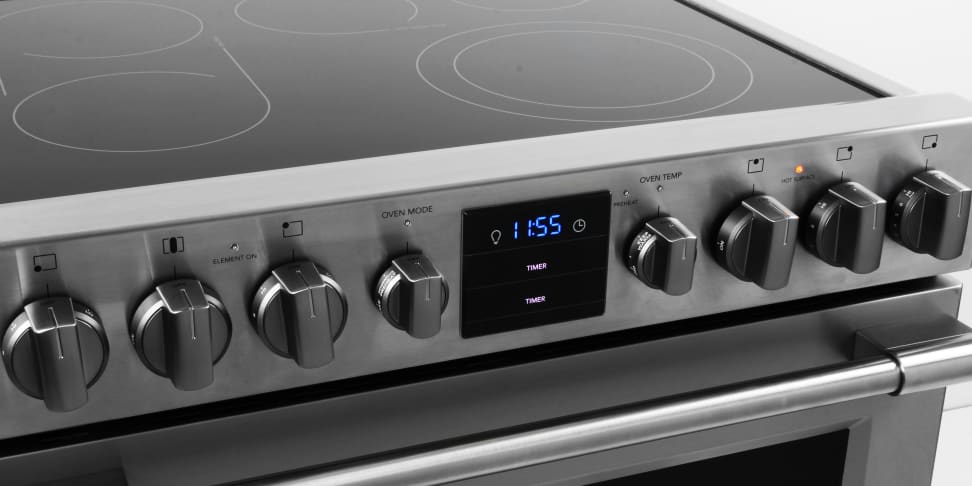 — Recommendations are independently chosen by Reviewed’s editors. Purchases you make through our links may earn us a commission.
— Recommendations are independently chosen by Reviewed’s editors. Purchases you make through our links may earn us a commission.We’ve updated this guide to include the Haier QSS740BNTS electric range. The Electrolux EI30EF45QS remains our Best Overall, and we plan to test more electric ranges to add to this list in the coming months.
Gas may be the pros' choice, and induction may be the (magnetic) wave of the future, but there's still plenty to be said for cooking with radiant electric heat. Electric ranges can provide an impressively wide temperature range, consistently excellent convection, and even heating across the board—great things to have if you enjoy cooking.
While the decision of which fuel to cook with might be out of your hands thanks to your choice of home, you still have plenty of options when it comes to the specific model. There are dozens of electric ranges to choose from, but lucky for you, we've put enough of these cookers through their paces to make some strong recommendations, including our best range, the Electrolux EI30EF45QS (available at AppliancesConnection for $2,198.10).
Here are the best electric ranges we tested ranked, in order:
- Electrolux EI30EF45QS
- Bosch HEI8054U
- Samsung NE59J7850WS
- Samsung NE59M6850SS
- Frigidaire Professional FPEF3077QF
- Kenmore Elite 95223
- Frigidaire FGEH3047VF
- GE JB655SKSS
- Haier QSS740BNTS
- GE JS645SLSS
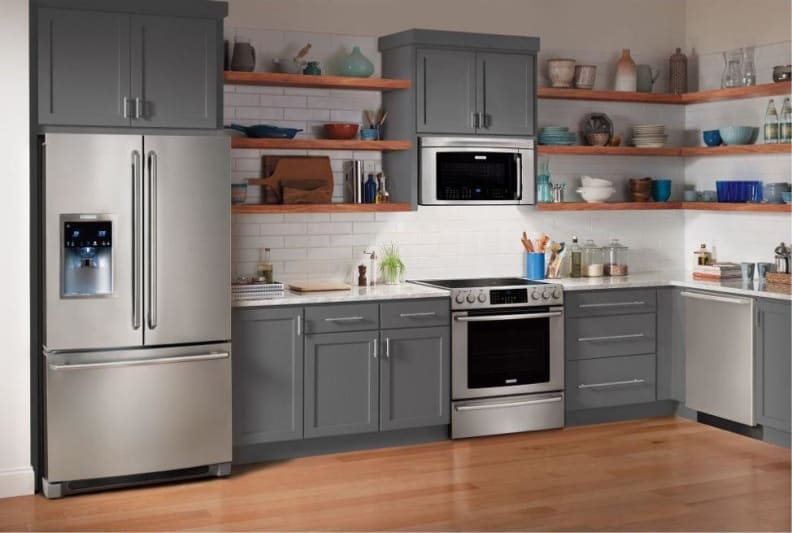

With its great cooking performance and cooktop that can reach temperatures of 770°F, we love the Electrolux EI30EF45QS electric range.
The Electrolux EI30EF45QS electric freestanding range has a lot going for it. Its sleek looks and versatile cooktop are definite crowd pleasers. The five cooktop burners include two simmer burners, a warming zone burner, one normal burner, and one tri-ring burner that promises very tight temperature controls. As a result, between these five burners, they manage to cover a temperature range of 85°F-770°F, which is no joke. While boiling times are a bit slow (about 6 minutes to boil 6 cups of water), that's to be expected on an electric range.
While the oven had no trouble perfectly roasting a pork loin, it had more difficulty when it came to baking cookies and cakes evenly. While the oven's baking isn't as even as we'd hoped, the oven has a built-in meat probe and hosts a number of useful cooking/baking modes such as Bake, Broil, Convection Bake, Convection Roast, Preheat, Slow Cook, Keep Warm, and Cakes & Breads. If you want very fine control when it comes to cooking with electric burners, look no further than the Electrolux EI30EF45QS.
Pros
-
Five burners cover wide temperature range
-
Includes built-in meat probe
-
Roasts well
Cons
-
Uneven baking
How We Tested
The Testers
Hi there! We're Madison Trapkin and Valerie Li, Reviewed's kitchen and cooking team. As passionate food and beverage aficionados who have covered topics like meal kits, pressure cookers, microwaves, and sous-vide immersion circulators,we know what it takes to make a great kitchen appliance. Whether you’re finally replacing an old range or have always wanted to add a wall oven while renovating your kitchen, we've got your back.
The Tests
Not only do we perform repeatable, lab-based tests on ovens, ranges, and cooktops, but we also do real-world evaluations (think: cookie baking, pizza cooking, and the like). That means we can tell you which products will perform the best, will give you the most bang for your buck, or have the sleekest looks.
Burner Temperature
For products with burners, we measure the maximum and minimum temperature of each burner to help consumers identify which burners are ideal for simmering soup, and which burner can get hot enough to properly sear a steak.
A range or cooktop with multiple burners that can reach very high and/or very low temperatures will score well. If burners cannot reach very high or low temperatures—or if only one burner can do each task—scores will be lower.
Time to Boil Water
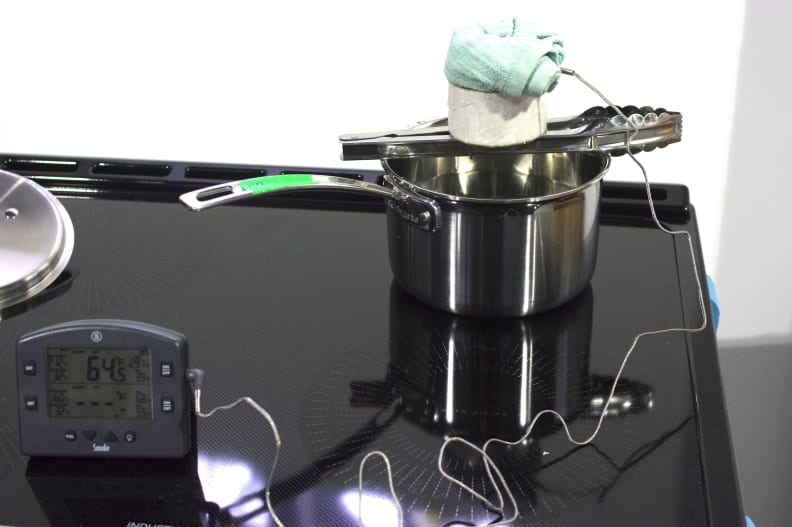
We know watching water boil is a bore, so we judge cooktops on how quickly they can actually boil a pot of water. Shorter boil times lead to higher scores.
One of the most common tasks for a range or cooktop is to boil a pot of water. For each burner, we take an appropriately sized pot, and fill it up halfway with distilled water. Then, we position a thermometer horizontally in the middle of the pot, and vertically in the middle of the water column. We monitor the thermocouple and record the time it takes for the temperature of the water to reach 212°F.
If the water hasn’t reached 212°F after 35 minutes, then we stop the test. Because the water volume is different for varying burner sizes, we score the water boil test on the rate of water boiling: Faster water boiling will result in higher scores, while slower water boiling will result in lower scores.
Time to Preheat
Using a stopwatch, we measure how long it takes for the oven to achieve a preheating temperature of 350°F. We stop the clock when the oven’s preheat indicator beeps.
Because no one wants to wait around forever, shorter preheating times result in higher scores, while longer preheating times result in lower scores.
How Evenly the Oven Bakes

We bake cookies in both standard bake and convection mode (if available) to see how evenly the oven can bake the cookies.
One happy side effect of testing ovens is that there are always extra cookies lying around. In addition to being delicious, cookies double as a cooking/baking proxy for other thin food items, such as brownies or vegetables.
We place 12 Pillsbury ready-to-bake sugar cookie chunks on an ungreased cookie sheet in a grid formation. After preheating the oven to 350°F for 15 minutes, we place the cookie sheet in the oven on the rack recommended by the manufacturer (or, if there is no recommendation, the middle rack) to bake for 15 minutes. We remove the cookies from the oven, and allow them to cool for 2 minutes.
We repeat the process if there’s a second oven, or if the range or oven comes with a convection option. Because convection is commonly used to bake or cook multiple food items simultaneously, we place two trays of cookies on the two racks recommended by the manufacturer.
After looking the cookies over, we determine how evenly baked they are, both within a single baking sheet (regular baking mode and second oven baking mode) and between multiple baking sheets (convection bake mode). Because convection is generally a more efficient way of cooking or baking something, it is important that the multiple food items on different racks be cooked or baked to the same degree.
For all of our cookie tests, the more evenly baked the cookies are, the higher the score will be. If the product has a second oven and/or convection capabilities, then the cookie scores for those tests and the main oven test are weighted and combined to arrive at a final cookie score. This way, products with just a single, conventional oven are not penalized for their lack of a second oven or convection capabilities.
How Well the Oven Cooks Meat

When it comes to cooking meat, we want to be sure that each oven is capable of cooking meat evenly and to safe eating standards (160°F).
To understand how each product cooks meat products, we also use fresh, never-frozen pork loins in our testing because they are exceptionally uniform as far as all-natural products go.
After placing the 3- to 4-pound boneless pork loin in a roasting pan, we place a temperature probe in the middle of the pork loin. We preheat the oven to 325°F, placed the pork on the rack recommended by the manufacturer, and cook until the internal temperature probe reads 160°F, which is the minimum safe temperature for cooking most meat products.
We then remove the pork loin, let it sit for 10 minutes, and cut it into thirds so we can see how evenly cooked it is. An identical test is conducted if the oven has convection capabilities, using the Convection Roast option if available, or the standard convection mode if not.
How Effectively the Oven Cooks Pizza

Can this oven get hot enough to cook a pizza? We put each oven to the test with a very basic pizza that has a temperature probe in it.
One of the most common reader questions we get is whether a specific oven can get hot enough to actually cook a pizza. To answer this question, we place a batch of Pillsbury Classic pizza dough on a lightly oiled baking sheet, put a temperature probe in the dough, cover it with tomato sauce and cheese, and bake it at 500°F for 10 minutes. Between the temperature data and our own subjective assessment, we determine whether the oven is capable of cooking a pizza all the way through or not.
Overall Experience
While we go to great lengths to test the cooking/baking abilities of these cooking appliances, we also incorporate more subjective information into our overall assessment. For example, how easily can the cooktop surface accommodate multiple pots and pans? How easy is it to understand the control panel? How nice are the burner knobs or buttons? How loud is the preheat notification noise? We answer all of these questions and more to determine if there are any major drawbacks to the product that might not make it a good fit for most households.
What to Consider When Buying a Range
Convection vs. True Convection
True Convection is an oven setting that includes installing an extra heating element and a fan in the oven. By adding an additional heating unit and fan that circulates the hot air, True Convection is great for ensuring that cookies or cakes baked on different racks will bake through at the same rate, rather than the cookies closest to the bottom heat source cooking faster than those on the rack higher up.
If you don't see mention of "True Convection" or "European Convection," but do see the words "convection oven" in a range's specs, it means that the unit lacks an additional heating element, but does have a fan to circulate the hot air. While you don't get the full baking and cooking effect that you would with True Convection, the added heat circulation can cook or bake food more evenly than it would without a fan.
There are also ranges out there that do not offer convection options at all; these ovens aren't bad, it will just take more time to cook and bake food all the way through. If you're a frequent baker or cook, convection can be a great time saver, but your dinners won't suffer unduly without it.
Slide-In vs. Free-Standing
While slide-in ranges are meant to sit flush with your countertops, free-standing ranges can stand alone in your kitchen. The difference may seem trivial, it has ramifications for two aspects of using the range: finish and ease of cleaning. Because free-standing ranges are visible from all slides, they have a more finished look on the sides of the range; slide-in ranges are meant to have their sides hidden by the cabinetry, so the finish typically isn't as pretty on the sides.
Additionally, because slide-in ranges sit flush with your countertop, they're a bit easier to clean because they do not have a large lip around the edge. Free-standing ranges often have larger lips and a back-mounted control panel to cut down on crumbs decorating your floor.
While slide-in ranges will do fine in a free-standing arrangement, the reverse is less true. If your current cooking setup has the range sitting in a cabinet or countertop cutout, we recommend replacing that range with another slide-in range. Conversely, if your range stands alone in your kitchen, we'd recommend replacing it with another free-standing range to cut down on food debris spilling everywhere.
Front-Mounted Control Panel vs. Back-Mounted Control Panel
Most free-standing ranges have back-mounted controls, but some slide-in ranges do as well. Both arrangements have pros and cons; on the one hand, having back-mounted controls means you may have to reach over hot food to adjust the oven temperature, but the controls are also far enough away that you would have difficulty hitting something on the control panel by accident.
On the other hand, front-mounted controls are easier to reach, but that convenience can turn against you if you brush up against a knob accidentally. Consider the ergonomics of using the range when it comes to picking a front- or back-mounted control panel.
Dimensions
If you need a slide-in range, double check both the dimensions of your cutout and the listed height/width/depth dimensions listed on the range's spec sheet. There are three dimensions listed for each range:
• Depth — The depth is the distance from the front of the range to the back of the range; this number typically varies from 26 inches to 30 inches because it's trying to sit flush with your cabinetry.
• Height — The height is the distance from the bottom of the range to the top of the range; this number typically varies from 36 inches to 38 inches because it's trying to get the cooking surface level with your countertops. (Note: If you see product heights on the order of 46-48 inches, that number is measuring to the top of the back-mounted controls, rather than the top of the cooking surface.)
• Width — The width is the distance from the left side of the range to the right side of the range; this number can vary widely, but the typical value is 30 inches (often, this is the dimension number you'll see when you first look at the range). Additional sizes include 36 inches, 48 inches, and 60 inches. While larger range widths are nice because it can translate into more burners and/or more space for your cookware, wider ranges always come with a higher price tag.
If you're getting a free-standing range, it's still worth it to check the product dimensions to ensure that the range will fit in your allotted range space in the kitchen, and that you can fit the range in through any narrow doorways on the way to the kitchen.
Additional Cooktop Options
Depending on how much time you spend in the kitchen, it might be worth it to invest in some extra options for your range. When it comes to the cooktop, anything above the standard four-burner setup is a bonus. Some ranges can have five, or even six burners; however, the more burners a rangetop has, the more difficult it becomes to fit large pieces of cookware, such as a spaghetti pot and a frying pan, on their respective burners at the same time.
Sometimes, those extra burners are designed to accommodate special cookware such as a griddle or a wok; other burners are bridge burners that are meant to keep food warm without continuing to cook it.
A dual-ring burner is a burner that includes a stronger heat source wrapped around a weaker heat source. That way, on a single burner, you can choose to use just the smaller heat source for lower temperatures, but you can add the stronger heat source if you need higher temperatures.
Additional Oven Options
Extra oven features can include everything from accessories like special oven racks or a temperature probe to special cooking features like convection settings, fast preheat, bread proofing (where the oven settings are customized to activate yeast and make bread rise), steam cooking (where you pour water into a reservoir and gently cook something with the resulting steam), air fry mode (where you can expeditiously fry frozen and fresh foods), and more.
Many ovens are self-cleaning, either by way of steam cleaning or pyrolytic cleaning, where the oven is heated to extremely hot temperatures to remove food residue. This process produces ash, which can vacuum or wipe out with a damp cloth after.
With some of the higher-end ranges, you can even choose to cook your food in one smaller oven or a larger oven, as needed. Lastly, it is possible to get a double-oven range, if you need the flexibility of two ovens, but still want a cooktop included in the same unit.
Fit and Finish
You should be able to find a range that matches your kitchen setup and your other appliances, but be ready to pay more money for any finish more sophisticated than black, white, or basic stainless steel.
Price
Don't worry: Whether you're on a budget or have a blank check, you can find a range that will cook, bake, and boil. Mostly, the price difference between high-end ranges and more affordable ranges is usually down to the number of cooktop burners, available features, storage drawers, and finishes.
Other Electric Ranges We Tested
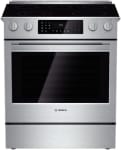
The 30-inch Bosch HEI8054U all-stainless electric range feels sturdy, looks great, comes with a ton of extra features and options, and performed well in our cooking and heating tests. While it takes a bit longer than usual to boil 6 cups of water, the cooktop burners are very versatile temperature-wise; they can reach temperatures between 110°F and 800°F.
We didn't get a chance to test out the numerous extra oven options including Bake, Variable Broil, Roast, Warm, Proof Dough, Convection Bake, Convection Broil, Convection Roast, Multi-Rack European-style Convection with conversion, Pizza, and Fast Preheat. However, our tests showed that this oven does a great job cooking meat all the way through, but may be a bit uneven in its heat application when it comes to cookies. If you need a versatile electric range with solid burners and many cooking options, the Bosch HEI8054U is a good fit.
Pros
-
Many cooking options
-
Performs well
-
Versatile burners
Cons
-
Slow boiling times
-
Uneven baking


Unlike a typical dual-oven range, the Samsung NE59J7850WS allows you to divide the 5.9-cubic-foot oven cavity in two on demand, offering a new level of adaptability. You can also bisect the door, but only when and if you choose. Along with the oven(s), the rangetop easily reaches searing heats or simmering lows. Whether you want to cook a Thanksgiving turkey or cook multiple meals at once, this range can fit your needs.
Pros
-
Cooktop heats very well
-
Adjustable dual oven
Cons
-
Uneven baking


We love the Samsung NE59M6850SS/AA electric range with convection. Its Flex Duo divider means it's three ovens in one package: It can function as a large, single oven, or you can simply slide in the divider to convert it into two smaller ovens for baking two things at once. This model also offers Wi-Fi for remote preheat, two powerful burners, great low-heat simmering, and some of the best roasting we've ever tested.
Pros
-
Roasts food well
-
Fast boiling
Cons
-
Uneven baking


The Frigidaire FPEF3077QF Professional electric range has the genuine and classic look of a high-end oven at a substantially lower price. But it's quite capable in the cooking department too: The 6.1-cubic-foot oven offers rapid preheat speeds and excellent overall cooking evenness. Whatever it may lack in ability, it makes up for in versatility.
Pros
-
Burner versatility
-
Plenty of convection settings
-
Affordable
Cons
-
Boiling takes a while on cooktop
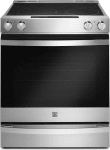
This upgraded Kenmore model really doesn’t disappoint. It has a ton of value-added features, like a triple burner, a warming drawer with five different heat settings, and a luxury-glide oven rack. Add that to the ability to bake on convection and steam baking settings and you really have a great package.
It might be a little slow to preheat, but once it gets up to temperature it bakes and roasts really nicely, scoring on the top end of our baking tests. The burners not only heat up to high temperatures but they can also simmer at nice low ones. Overall, you could do much worse than this Kenmore model.
Pros
-
Great min and max temperatures
-
Lots of great features
Cons
-
Slow to preheat
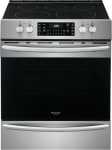

If you like to multitask in the kitchen, then you'll love the Frigidaire FGEH3047VF. This range has five burners, the front two of which have multiple rings, and can reach temperatures well over 800°F. The oven gets hot enough to cook a pizza (at 500°F), and makes baking evenly baked cookies look like a cake walk.
The real selling point of this range is that it comes with an Air Fry mode, which works best with the air fry tray that you can purchase separately. Our tests showed that the Air Fry mode worked beautifully. We're on the record as saying that you don't really need an air fryer, but if you want the option to speed up the frying process without having to drop the cash for an air fryer, this range is a great option.
Pros
-
Front burners are customizable
-
Range and oven can get very hot
-
Air fry-compatible
Cons
-
None that we could find


There’s a reason why GE is the most popular brand for cooking appliances in the U.S.: It makes a solid product. The GE JB655SKSS is no exception. It does an excellent job at roasting and broiling, but may not be the best bet for serious bakers: Our cakes came out pretty uneven. On average, it takes the burners about 9-10 minutes to boil 6 cups of water, but the right-front burner was able to boil that amount of water in under 4 minutes, which is pretty speedy. Overall, this range is a good deal for what it does and consumers agree.
Pros
-
Decent cooktop performance
-
Great at roasting and broiling
Cons
-
Poor cooktop control layout
-
Uneven baking temperatures
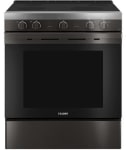
The Haier QSS740BNTS certainly has plenty of features that will delight tech nerds everywhere, assuming you don’t mind using an app to cook, as many of this range's functions (including temperature control and a timer) are only accessible via the SmartHQ app. But serious home cooks might want to go with a higher performing model as this range struggled to bake cookies evenly, cook pizza all the way through, and perfectly brown pork.
Pros
-
Attractive design
-
Includes built-in meat probe
-
Remote preheat
Cons
-
Uneven baking
-
Can’t use many features without app
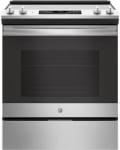
The GE JS645SLSS Electric Range is easy on the eyes and it faired well on most of our tests, baking cookies particularly evenly. But this 30-inch slide-in range is missing convection, so you can forget about achieving air fryer-like crispiness. This function is super basic and there’s really no reason an oven shouldn’t have it, especially one that’s over $1,000.
Pros
-
Sleek design
-
Even baking
Cons
-
No convection
-
Slow boil times